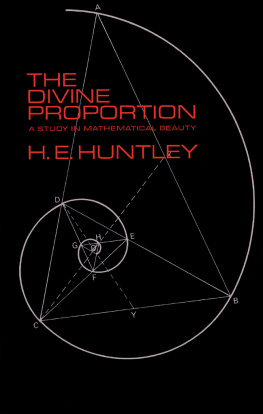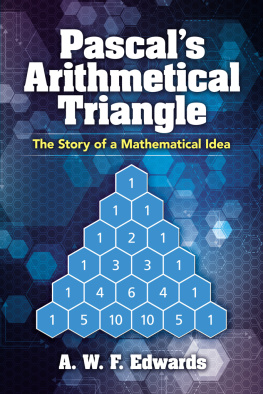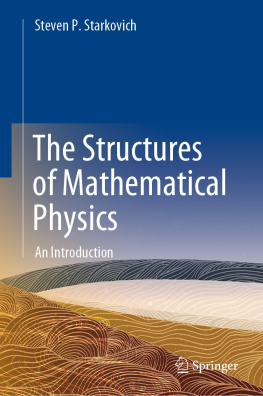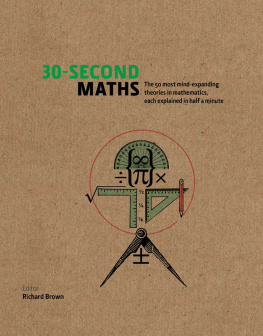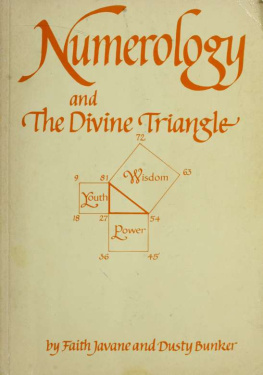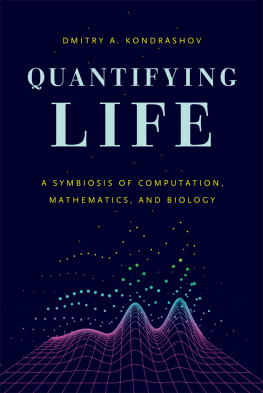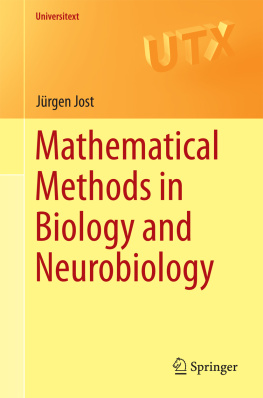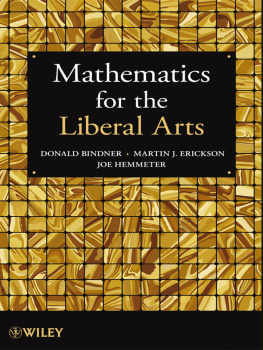OTHER BOOKS BY H. E. HUNTLEY
Dimensional Analysis, Macdonald & Co. Ltd., London (Reprinted by Dover Publications, Inc.).
Nuclear Species, Macmillan & Co., Ltd., London.
The Faith of a Physicist, Geoffrey Bles, London.
THE DIVINE PROPORTION

Radiograph of the shell of the chambered nautilus (Nautilus pompilius), a beautiful and well-known modern sea shell. The successive chambers of the nautilus are built on a framework of a logarithmic spiral. As the shell grows the size of the chambers increases but their shape remains unaltered (courtesy Kodak Limited, London).
THE DIVINE PROPORTION
A Study in Mathematical Beauty
by H. E. HUNTLEY
DOVER PUBLICATIONS, INC., NEW YORK
Copyright 1970 by Dover Publications, Inc.
All rights reserved.
The Divine Proportion: a Study in Mathematical Beauty is a new work, first published in 1970 by Dover Publications, Inc.
Standard Book Number: 48622254-3
Library of Congress Catalog Card Number: 70-93195
eISBN 13: 978-0-486-13187-0
Manufactured in the United States by Courier Corporation
22254327
www.doverpublications.com
Preface
Having taught mathematics and physics to students of university standard for thirty years, I find myself still facing the didactic difficulty that confronted me when I first began to teach, viz., how to instill in adolescent minds the best, and perhaps the only enduring motive for reading mathematics, which, in my view, is the aesthetic motive.
Like the improvement of a bodily skill, the appreciation of beauty in any form can be developed with practice. This involves presenting the learner with objects of beauty for his appraisal; in the present instance with a collection of mathematical specimens of acknowledged aesthetic appeal. Anthologies of poetry or of music are not hard to come by: Gems from Shakespeare or Collected Folk Songs are familiar titles, so why should not a comparable collection be made for mathematics, which after all is an art form? To the aesthetically minded mathematician much mathematics reads like poetry. Then let the following collection be read as an anthology, which, in the Greek derivation, is a collection of flowers. As far as I know it is the first of its kind.
The topics discussed are simple; they are all more or less directly connected with the golden section of the Greeks. The author hopes that the essay will not only make an aesthetic appeal to the reader, but will also stimulate his own creative activities, for the experience of creating something new or of uncovering some hidden beauty is one of the most intense joys that the human mind can experience.
I am glad to express my gratitude to my friend, Charles Clutter-buck of Bath University, for his skilful execution of the drawings and to Mr. Peter Kurz for reading the manuscript and for many helpful suggestions.
Hutton, | H. E. HUNTLEY |
Somerset, |
U.K. |
Beauty is a conspicuous element in the abstract completeness aimed at in the higher mathematics; it is the goal of physics as it seeks to construe the order of the universe; it ought at least to be the inspiration of all study of life.... It raises for us the question of the depth and reach of our awareness. This needs the poets prayer that more of reverence in us dwell.
JOHN OMAN, The Natural and the Supernatural
Euclid alone has looked on Beauty bare...
EDNA ST. VINCENT MILLAY, Sonnet
Introduction
The theme of this book is the aesthetic appreciation of mathematics. Poincars remark that ... but for harmony beautiful to contemplate, science would not be worth following is applicable also to his own discipline, mathematics. K. Weierstrasss dictum that No mathematician can be a complete mathematician unless he is also something of a poet, recalls Poincars: The mathematician does not study pure mathematics because it is useful; he studies it because he delights in it and he delights in it because it is beautiful. Since the purpose of these pages is didactic, it has been necessary to consider how the readers emotion could be stirred as he exercised his intelligence in following a mathematical argument; how a mathematical idea could be made to be both convincing by its logic and moving by its beauty. Three steps seem to be required, which, though they may be necessary, may not in themselves always be sufficient, to kindle the spark of aesthetic feeling into a flame.
First, if we seek to implant in the budding mathematician a feeling for beauty in the topics which he studies, we must confront him with beautiful specimens. No argument would convince a blind man of the beauty of a rainbow; he must see it. Accordingly, in the following pages is presented a short anthology, a selection of mathematical specimens which experience shows to have aesthetic appeal. The field of choice, however, is so wide that a strict rule of limitation is expedient. It would not be too difficult to range widely and write a sort of mathematical belles-lettres, but the alternative was preferred and it will be found that all the specimens selected are related to a single idea, one that appealed strongly to the aesthetic sensibilities of the ancient Greeks from the days of Pythagoras, viz., the divine proportion and the related topic, the Fibonacci series. The basic idea is simple; most of the cognate topics are within the competence of high school pupils. The inference the reader may be expected to make is that, if so restricted a field contains so many gems, the whole realm of mathematics must be rich indeed!
Second, some preliminary education related to the selected specimens is needed. A limited sense of aesthetic appreciation is given; the rest must be acquired. For example, the mathematically uneducated can easily appreciate the dual symmetry of an ellipse; that is given. But the unlimited store of beauty of the conic sections is reserved for the mathematically trained: it is acquired. This indicates that the path to real aesthetic pleasure is through toil, a principle that holds far beyond the realm of mathematics. Spade work is essential: per ardua ad astra.
Third, the neophyte must be encouraged to help himself. The Socratic method is best here, and the reason is simple. The appreciation of beauty is scarcely to be distinguished from the activity of creation. In the moment of appreciation we... reenact the creative act, and we ourselves make the discovery again. Self-help is the royal road to intuitional glimpses of truth and to discoveries which, even at secondhand, bring with them the joy of creative activity.
To summarize: to induce aesthetic pleasure, select a suitable object, acquire the relevant education and help yourself.
EXERCISE OF A SKILL
There are of course other sources of pleasure in the pursuit of mathematics than the appreciation of beauty. There is, for instance, the exercise of mental skills. Mathematics is a language, and skill in its use can afford great satisfaction. J. Bronowski writes:
Mathematics is in the first place a language in which we discuss those parts of the real world which can be described by numbers or by similar relations of order. But with the workaday business of translating the facts into this language there naturally goes, in those who are good at it, a pleasure in the activity itself. They find the language richer than its bare content; what is translated comes to mean less to them than the logic and the style of saying it; and from these overtones grows mathematics as a literature in its own right. Mathematics in this sense is a form of poetry, which has the same relation to the prose of practical mathematics as poetry has to prose in any other language. The element of poetry, the delight in exploring the medium for its own sake, is an essential ingredient in the creative process.
Next page
